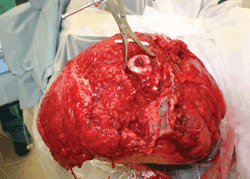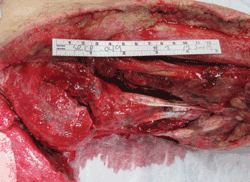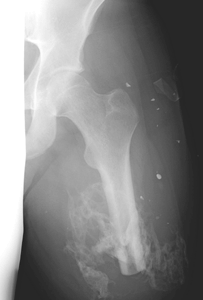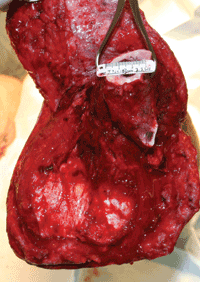Heterotopic ossification of combat wounds contains 40 times more osteogenic progenitor cells than controls
Researchers prospectively studied cell activity in wound muscle biopsies from active duty soldiers, comparing that to heterotopic ossification rates on radiographs.
 Frederick P. O’Brien |
 Thomas A. Davis |
Several studies show higher rates of heterotopic ossification following combat wounds than civilian injuries. Further highlighting the uniqueness of this abnormal bone regeneration among wounded warriors, a study performed by the United States Navy detected a markedly increased number and proliferative capacity of muscle-derived mesenchymal stem cells in combat wounds compared to uninjured muscle.
Orthopedic surgeon and fourth-year resident at Walter Reed Medical Center, Bethesda, Md., Frederick P. O’Brien, CPT, MC, MD, worked with stem cell biologist Thomas A. Davis, PhD, at the Naval Medical Research Center, Silver Spring, Md, and other investigators, to study the heterotopic ossification (HO) that can result from acute and prolonged inflammation and other factors following wartime injuries.
“The formation of HO is a complex process. We were encouraged to find that there was a relationship between growth characteristics of cells taken from biopsies soon after injury and the development of HO later in the treatment course,” O’Brien told Orthopedics Today.
“We might have another piece of information that will give us an early sense of who is going to develop HO.”
HO occurs about four times more often in those injured during the Iraq conflict vs. other conflicts, according to the researchers.
Identifying at-risk patients
The clinical problem that currently exists is that when HO is seen in injured patients it may be discovered well into the healing process and rehabilitation, making any surgical excision of the heterotopic bone — the main treatment for such problematic HO — extremely involved.
“They are difficult surgeries. The lesions are very vascular, there is a lot of bleeding … It really sets them back,” O’Brien explained.
Therefore, researchers sought to learn who was at risk for developing HO based on signals contained in the cells of the tissue surrounding the wound.
“The wound microenvironment and the signals driving the abnormal growth of and development of cells of the bone lineage in muscle tissue in these patients could be a problem,” Davis said, which may explain why in wartime injuries, HO rates of about 63% seen in some studies compared to 10% to 20% HO rates with civilian injuries.
During their preliminary pre-clinical work, the team identified a specific stem or progenitor cell associated with HO and in an animal study developed the assay they eventually used in the human trial.
|
|
|
Cells studied
“Our hypothesis was that patients who develop HO early have more mesenchymal stem cells (MSCs) with the potential to grow into bone-growing cells and trophic factors that orchestrate the repair process,” Davis said.
The blinded prospective study quantified and characterized MSC and progenitor cell activity. Investigators enrolled 25 patients who were injured active-duty service members with blast or penetrating extremity injuries. During debridement at approximately 3 to 5 days post-injury, which occurred after the soldiers returned to the United States, investigators biopsied the muscle tissue surrounding the wound and used special methods for tissue digestion, cell suspension, and in vitro culturing for analysis.
For the control group they used biopsies of uninjured hamstring autografts from six patients undergoing elective ACL surgery.
Patients in the first group were followed radiographically. Interim results showed 14 of 25 injured patients (56%) developed HO between 56 and 115 days post-injury. About 40 times more of the osteogenic progenitor cells were found in the traumatized muscle tissue than the control tissue, Davis noted.
|
|
|
Images: O’Brien FP, Davis TA |
Conclusions
“The percentage of wounded warriors in our case who did develop HO, at this point, appears to be close to what is currently reported in larger retrospective studies,” O’Brien said. If HO is going to form following a trauma, it typically does from several weeks to a couple of months post-injury, he added.
Discussing the culture results, Davis said, “You see a different cellular response of the cell type that appears to be playing a critical part in formation of the lesion. At the gene level, we see that the cells that we are able to pull out and culture and expand in a very short time at a colonal level are already, at 3 to 4 days post-injury, expressing certain genes that are osteogenic in nature.”
This cell population appears to be a dynamic entity which changes constantly, said Davis, who envisions these findings eventually leading to a diagnostic tool kit that clinicians can use just a few days post-injury to see who has a likelihood of developing HO. “It would help the patient,” he said.
The researchers expect to enroll more patients in this study, which won them the Robert A. Phillips Award during the 2nd National Capital Region Military Research Competition and the Approved Clinical Investigation Program Research, Resident-Level, at the 2010 Navy-wide Academic Research Competition as well. – by Susan M. Rapp
Frederick P. O’Brien, MD, and Thomas A. Davis, PhD, NMRC, can be reached at Chris.Walz@med.navy.mil. O’Brien can be reached at Orthopaedic Department-Code 2230, 8901 Wisconsin Ave., Building 54 Receiving, Bethesda, MD 20889-5000.
This paper supports the role of a local influence (injury severity) on MSCs from muscle in the cascade of exuberate callus and possibly some types of HO formation.
Many questions remain. Does the wartime injury create a systemic response as well? HO is noted in patients with multiple fractures (at and away from the fracture site), traumatic brain injury (TBI), spinal cord injury (SCI) and thermal injuries. In these entities multipotential cells must migrate to an area prior to forming bone. Are they coming from muscle or the vascular system? Burns frequently develop HO at the elbow, but the burn is often located elsewhere; neurogenic bone most commonly forms in tissue planes away from the site of injury. The location is further complicated by the fact that HO sites at the hip vary between SCI and TBI. Local and systematic factors must occur as is documented in the varying locations and incidences of TBI-HO at the hip: TBI neurogenic HO, 3%; fracture dislocation with TBI, 40%; fracture dislocation with ORIF, 80%. Local trauma and/or a common pathway from various etiologies cannot completely explain HO formation, since different mechanisms must direct MSCs to specific locations.
If we do not already have a large enough conundrum, a relatively newer entity has emerged — intubation HO. Acute respiratory distress often requires medically induced complete muscle paralysis. If intubation is prolonged (up to 1 month) HO may occur at the hip and knee. No injury severity or neurogenic stimuli, our most treasured tenets, are involved. Somehow an “inflammatory response” may be the culprit, but how?
– Douglas E. Garland, MD
Orthopedics
Today Editorial Board member
Long Beach, Calif.
![]() Follow
OrthoSuperSite.com on Twitter
Follow
OrthoSuperSite.com on Twitter





